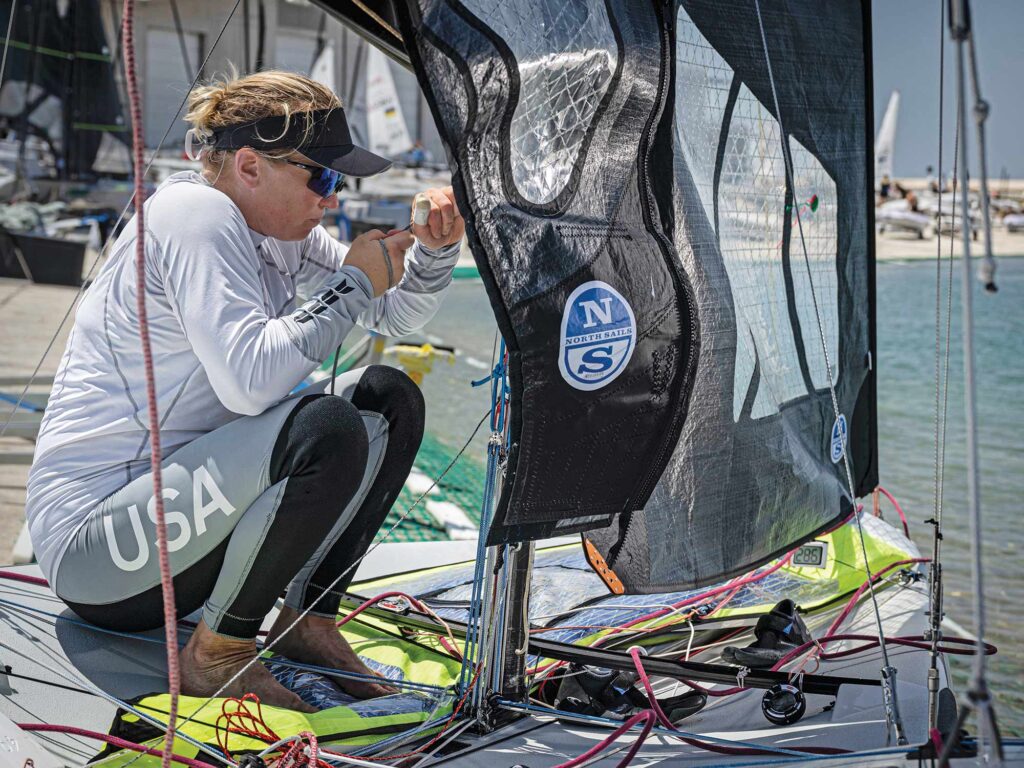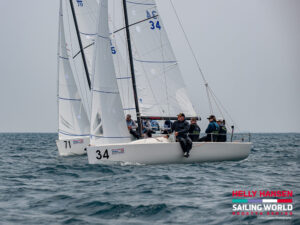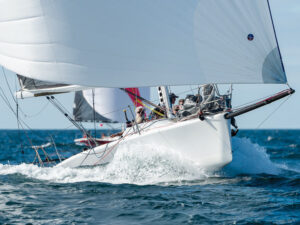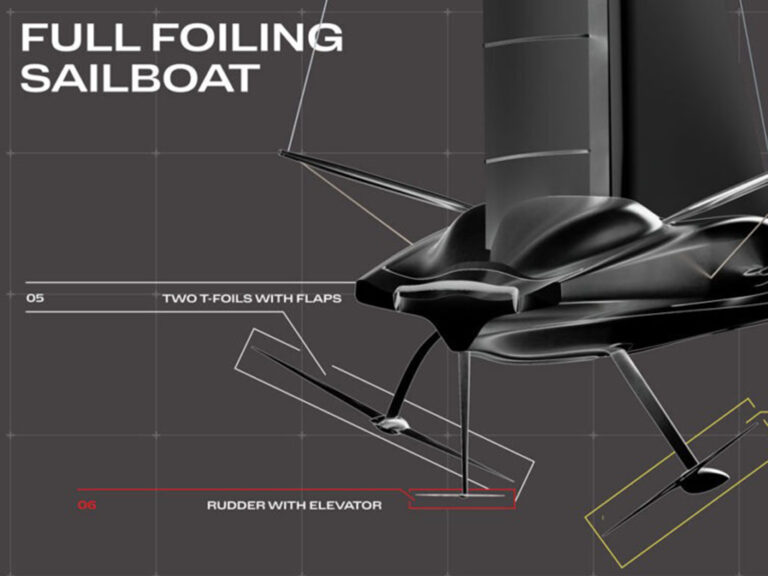
When boatspeed comes up in a debrief with your team, ask yourself: Did we put ourselves in a position to be fast on the racecourse? If the answer is no, do not waste your time on the topic. A few things have to be good enough before you leave the dock. Will your sails and hull allow you to be competitive? Is your team close to the overall target weight? The best sailors can make slow boats and old sails go fast, but for most of us mere mortals, it’s much harder with bad gear.
There are a few more caveats on the racecourse. If your upwind lane is compromised, you cannot evaluate your boatspeed. Even the fastest sailors in the fleet cannot defy the physics of being on another boat’s windward hip. Instead, they are usually better at tacking away before too much distance is lost. Also, a boat can be optimally set up, but improperly trimmed sheets or an erratic hand on the tiller will make it perform like it’s towing a clump of weeds.
All this is to say it’s critical that you make sure your team is doing the big things well—getting off the starting line, choosing smart moments to tack, and executing reasonable trimming and driving technique—before blaming boatspeed.
Aside from boat-specific equipment optimization, any speed-related problem-solving on board requires solid communication between the skippers and trimmers. The words we use matter; onboard communication related to speed should be concise, direct and actionable. On board the 49erFX, for example, my teammate Stephanie Roble will often tell me the “boat won’t release” when a puff hits. When I hear this, I know we need more twist in the mainsail. Here, Steph is giving me feedback that I can act on and address. When using adjectives to describe the boat’s performance, make sure you’re all on the same page about the meaning of terms such as “sticky,” “wobbly” or “narrow groove.” Ultimately, if the boat is set up properly, speed-related communication should be mellow. A quiet boat is a fast boat.
The tiller gives us some of the most valuable onboard feedback about the setup of the mainsail and jib in relation to each other. When sailing upwind with the sheets fully trimmed and the crew hiking appropriately, have the skipper release their grip on the tiller and take note of what happens to the bow. If there is a strong reaction to leeward or windward, you might have an imbalance in the setup of the mainsail and jib. If the bow gets pulled too leeward, away from the wind, it can indicate that your jib is too powerful or the mainsail could take more leech load. The opposite might be true if the boat wants to naturally round up when the skipper eases their grip on the tiller. If so, your mainsail might be too powerful. On most dinghies, the helm will not ever be totally neutral, but an extreme windward or leeward helm tug indicates you can find a better balance between the mainsail and jib. To keep things really simple, sometimes I ask Steph, “Are you pushing or pulling the helm?”
When you sail upwind to check settings, ensure the skipper and trimmer are aligned on wind strength and where it leaves you in the power curve. Are you searching for power, trying to use the max power available, or needing to depower your setup? The answer usually varies across the day’s wind conditions, such as: “Overpowered in the puffs, but OK on average.” This analysis should lead you to the next decision about whether you set up for the puffs or lulls. The sea state will influence which way you hedge. In flat water, you can feather into the wind when a puff hits to depower more easily. In a wavy sea state, you have to drive around the waves, so your setup will need to allow a wider groove.
To simplify the many decisions needed to properly set up your boat, let’s rely on data whenever possible. Your tuning guide for the rig should be scaled to wind strength and sea state. Your homework before the day of racing should include understanding the ranges of wind strength you are likely to see and memorizing or recording the high and low tide times. The easiest but rare days are, of course, those with consistent wind strength. But on days when you get every windspeed possible, it’s helpful to understand where you are at any given moment in the greater trend. Knowing if the puffs you’re feeling are reaching the maximum forecast for the day, or vice versa with the lulls, should help you hedge your settings for the upcoming race. It really helps us decide on the rig setting when we can say something like, “This lull is the lightest velocity we were meant to see, so let’s anticipate a build from here.”
It is critical for trimmers to identify which sail controls will have the biggest impact. On a hiking or trapezing boat, sacrificing crew weight in the right place to make a control adjustment, like the cunningham or vang, comes with a cost-benefit analysis every time. On the 49erFX, for example, which weighs about 100 kg, the crew’s body weight of approximately 70 kg makes a bigger difference in most puffs than one last inch of cunningham. In an ideal world, control adjustments would happen before the puff or lull hits. But if you get caught out by a puff, before leaning in, ask yourself: Will easing the mainsheet a little more or having the extra bit of cunningham on help us more at this moment? And more so, if the puffs are short-lived, you should not aim for perfection. On high-tempo, transitional days, Steph and I will agree that we are going for 80 percent boat performance, and we both try to find a forgiving and versatile setup on our sheets.
Lastly, keep in mind that if you’re caught out at the wrong rig setting, it’s likely the majority of the fleet is as well. Don’t let it become a mental distraction during the race. Announce to the team, “We are overpowered; the boat is not going to feel great.” Doing so can help eliminate any distracting input and focus everyone’s attention on going as fast as possible in the moment.









